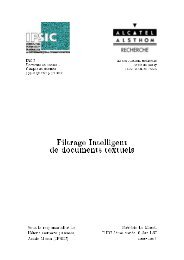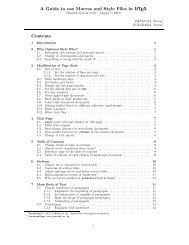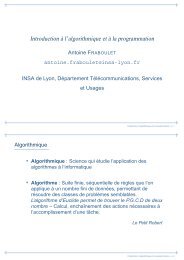Single-Chip Low Cost Low Power RF-Transceiver (Rev. A)
Single-Chip Low Cost Low Power RF-Transceiver (Rev. A)
Single-Chip Low Cost Low Power RF-Transceiver (Rev. A)
Create successful ePaper yourself
Turn your PDF publications into a flip-book with our unique Google optimized e-Paper software.
CC250031 Configuration RegistersThe configuration of CC2500 is done byprogramming 8-bit registers. The configurationdata based on selected system parametersare most easily found by using the Smart<strong>RF</strong> ®Studio software. Complete descriptions of theregisters are given in the following tables. Afterchip reset, all the registers have default valuesas shown in the tables.There are 14 Command Strobe Registers,listed in Table 34. Accessing these registerswill initiate the change of an internal state ormode. There are 47 normal 8-bit ConfigurationRegisters, listed in Table 35. Many of theseregisters are for test purposes only, and neednot be written for normal operation of CC2500.There are also 12 Status registers, which arelisted in Table 36. These registers, which areread-only, contain information about the statusof CC2500.The two FIFOs are accessed through one 8-bitregister. Write operations write to the TX FIFO,while read operations read from the RX FIFO.During the address transfer and while writingto a register or the TX FIFO, a status byte isreturned. This status byte is described in Table17 on page 21.Table 37 summarizes the SPI address space.The address to use is given by adding thebase address to the left and the burst andread/write bits on the top. Note that the burstbit has different meaning for base addressesabove and below 0x2F.AddressStrobeNameDescription0x30 SRES Reset chip.0x31 SFSTXON Enable and calibrate frequency synthesizer (if MCSM0.FS_AUTOCAL=1). If in RX (with CCA):Go to a wait state where only the synthesizer is running (for quick RX / TX turnaround).0x32 SXOFF Turn off crystal oscillator.0x33 SCAL Calibrate frequency synthesizer and turn it off (enables quick start). SCAL can be strobed in IDLEstate without setting manual calibration mode (MCSM0.FS_AUTOCAL=0)0x34 SRX Enable RX. Perform calibration first if coming from IDLE and MCSM0.FS_AUTOCAL=1.0x35 STX In IDLE state: Enable TX. Perform calibration first if MCSM0.FS_AUTOCAL=1.If in RX state and CCA is enabled: Only go to TX if channel is clear.0x36 SIDLE Exit RX / TX, turn off frequency synthesizer and exit Wake-On-Radio mode if applicable.0x38 SWOR Start automatic RX polling sequence (Wake-on-Radio) as described in Section 19.5.0x39 SPWD Enter power down mode when CSn goes high.0x3A SFRX Flush the RX FIFO buffer. Only issue in IDLE, TXFIFO_UNDE<strong>RF</strong>LOW or RXFIFO_OVE<strong>RF</strong>LOWstates.0x3B SFTX Flush the TX FIFO buffer. Only issue in IDLE, TXFIFO_UNDE<strong>RF</strong>LOW or RXFIFO_OVE<strong>RF</strong>LOWstates.0x3C SWORRST Reset real time clock.0x3D SNOP No operation. May be used to pad strobe commands to two bytes for simpler software.Table 34: Command strobesPRELIMINARY Data Sheet (<strong>Rev</strong>.1.2) SWRS040A Page 51 of 83


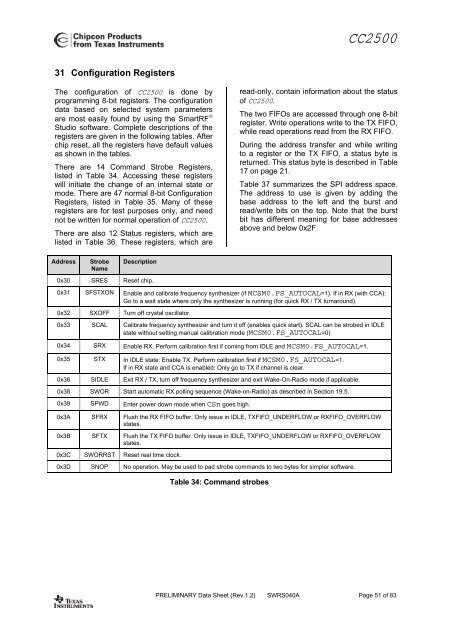
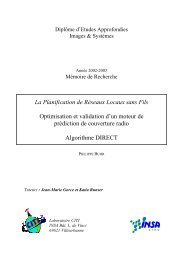
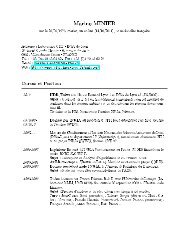

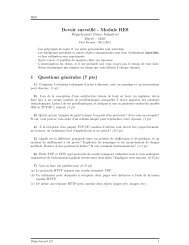

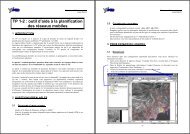
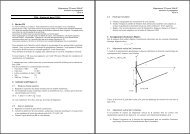
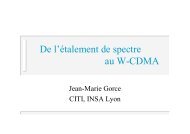
![td-res-4 [Compatibility Mode]](https://img.yumpu.com/45826987/1/184x260/td-res-4-compatibility-mode.jpg?quality=85)
